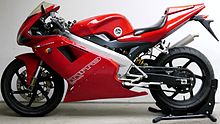Cagiva Mito
| Cagiva 125 Mito | |
|---|---|

|
|
| Mito Evolution 2 (2000-2007) | |
| Manufacturer | Cagiva |
| Production period | 1989 to 2011 |
| class | motorcycle |
| design type | Super athlete |
| Motor data | |
| 2-stroke, 1 cylinder, water-cooled | |
| Displacement (cm³) | 124.63 |
| Power (kW / PS ) | 11/15 or 22/30 |
| Torque ( N m ) | 14th |
| Top speed ( km / h) | 127 (11 kW) or 178 (22 kW) |
| transmission | 6 or 7 (until 1999) |
| drive | Chain |
| Brakes | v: disc (320 mm) h: disc (230 mm) |
| Wheelbase (mm) | 1375 |
| Dimensions (L × W × H, mm): | 1980 × 760 × 1100 |
| Seat height (cm) | 76 |
| Empty weight (kg) | 128 |
| Previous model | Cagiva Freccia 125 |
The Cagiva Mito ( mito : ital. "Myth") is a by the Italian manufacturer Cagiva produced motorcycle with 125 cc displacement and a power of 22 kW (30 hp).
technology
The Cagiva Mito is particularly popular with young people because of its sporty appearance.
For models built after 2000 (N3), the manufacturer may not issue any technical reports on the completely dethrottled variant (22 kW), but only as an 11 kW (15 PS) variant in Germany. The background to this is an EU guideline that prescribes a minimum weight per kW output and which the Cagiva Mito falls below.
In order to have a model built after 2000 approved as a completely dethrottled variant in Germany, a separate report on this increase in performance is required. This report is to be provided for each individual motorcycle, whereby the approval is then at the discretion of the TÜV expert. In the event of such an unintended increase in performance, the entire motorcycle is checked to see whether the chassis, the frame and the braking system in particular are designed for the high loads and speeds. Since the design of the relevant parts of the Mito has never changed since the Evo model, these tests should be in favor of the entry.
The Mito is powered by a single-cylinder 2-stroke engine with 124.3 cm³ displacement and separate lubrication. Depending on the model, carburettors with a diameter of 28 mm and 35 mm were installed. In principle, the engine technology has not changed since the Mito 1 was designed.
The Mito has been in production since 1989; first known as Mito I and Mito II, the design changed in 1995 and the name became Mito Evolution . Like the Ducati 916, the design of the Mito Evo comes from Massimo Tamburini , which is the result of the collaboration between the development departments between Cagiva and Ducati .
Versions
From 1989 to 1999 the Mito was built exclusively as a 7-speed version with three-spoke wheels. The special Eddie Lawson and Lucky Explorer models with special paintwork were an exception ; the former also differed in technical details from the normal version. Since 2000, the Cagiva Mito is only available with a 6-speed gearbox, 6-spoke wheels, aluminum rear silencer (previously Kevlar, which tends to discolour) and with reduced compression, as well as a 2-ring piston (previously 1-ring ) produced. The older models with 1-ring pistons have a 200H cylinder head, the newer models have a 200C cylinder head. The Swiss model is an exception, in which the output was further reduced with even lower compression and two less overflow channels.
In 2005, Cagiva presented the most modern version of the Mito, the Mito 525 SP, to the public. Although the overall concept of this model is based on the road version, it has been technically modified as a racing vehicle. This concerns z. B. the aerodynamic racing fairing with frontal air inlets, carbon parts, lightweight forged wheels and the elimination of all components required for road traffic such as headlights, indicators, etc.
The 2008 street model of the Cagiva is also called 525 SP and its design is based on this. But what is really special is the change to the engine. Cagiva has brought the 22 kW engine, which has been in production since the early 1990s, to the Euro 3 standard. For this, the mixture preparation had to be changed. The new system is called ECU (Electronic Carburetor System). It has various sensors and servomotors in order to achieve an optimal mixture formation in every operating condition and thus reduce pollutant emissions. The oil pump is also electronically controlled.
The production of the Cagiva Mito was stopped in 2011. The Cagiva brand now only exists pro forma ; MV-Agusta holds the trademark rights to Cagiva.

